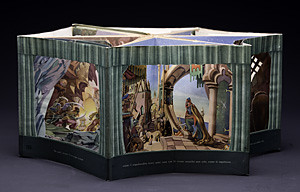Wishlist: To see this ;)
The Smithsonian Institution Libraries is planning an exhibition featuring the art of paper engineering in the production of books with moving parts (e.g., peep shows, volvelles, accordion books, pop-up books, etc.) published from15th century to modern times.

Fold, Pull, Pop & Turn: Books That Move brings together more than fifty remarkable examples of books—created over the past 500 years to explore themes related to their design, history, educational and social relevance. The exhibition will attract families with young children, casual museum visitors, and—more advanced students of book design and paper engineering; they will experience the diverse ways in which mechanical books have been magically transformed, enhancing their ability to both educate and entertain.
 The art of the book appeals to educators and art teachers seeking examples for class projects and to all who are fascinated by how things are constructed. A series of lectures by paper engineers and collectors will supplement the exhibition; a workshop will teach participants how to make a movable book. Interactive videos will demonstrate paper engineering techniques.
The art of the book appeals to educators and art teachers seeking examples for class projects and to all who are fascinated by how things are constructed. A series of lectures by paper engineers and collectors will supplement the exhibition; a workshop will teach participants how to make a movable book. Interactive videos will demonstrate paper engineering techniques.
There will also be this online version that will allow those who are unable to come to Washington, D.C. to see the exhibition and to provide additional learning materials.—Elizabeth Periale
Though not developed solely as a historical survey of pop-up and movable books, the upcoming show, Fold, Pull, Pop & Turn: Books That Move includes key examples of printed works published from 1476 up to 2008. It will be the first opportunity for many visitors to see some of the rarest examples of this book art form in rare treasures from Smithsonian Libraries collections, including works by Euclid & Apianus, and Descartes.
At the same time, visitors will view later works—some new and some familiar—represented by major paper engineers and designers such as van der Meer, Pienkowski, Lentz, Pelham, Sabuda, and Fischer.
The visitor experience will be multi-fold: to discover that pop-ups and movables have a long and significant history; to get a sense of the key publications from periods of history; and, to be introduced to the major designers who promoted paper engineering in the past up to the present day.—Elizabeth Periale
The art of how these magical constructions of paper engineering work will be a major focus of the exhibition, Fold, Pull, Pop & Turn. The show will be arranged by construction type in four areas:
Fold, Pull, Pop & Turn: Books That Move brings together more than fifty remarkable examples of books—created over the past 500 years to explore themes related to their design, history, educational and social relevance. The exhibition will attract families with young children, casual museum visitors, and—more advanced students of book design and paper engineering; they will experience the diverse ways in which mechanical books have been magically transformed, enhancing their ability to both educate and entertain.
There will also be this online version that will allow those who are unable to come to Washington, D.C. to see the exhibition and to provide additional learning materials.—Elizabeth Periale
Though not developed solely as a historical survey of pop-up and movable books, the upcoming show, Fold, Pull, Pop & Turn: Books That Move includes key examples of printed works published from 1476 up to 2008. It will be the first opportunity for many visitors to see some of the rarest examples of this book art form in rare treasures from Smithsonian Libraries collections, including works by Euclid & Apianus, and Descartes.
At the same time, visitors will view later works—some new and some familiar—represented by major paper engineers and designers such as van der Meer, Pienkowski, Lentz, Pelham, Sabuda, and Fischer.
The visitor experience will be multi-fold: to discover that pop-ups and movables have a long and significant history; to get a sense of the key publications from periods of history; and, to be introduced to the major designers who promoted paper engineering in the past up to the present day.—Elizabeth Periale
The art of how these magical constructions of paper engineering work will be a major focus of the exhibition, Fold, Pull, Pop & Turn. The show will be arranged by construction type in four areas:
- movables (primarily books that have movable parts that do not emerge from the surface of the page)
- pop-ups (book that in variant ways do emerge from the page)
- folding books (accordion forms)
- fantastic forms (that use multiple constructions)
Thank God there's an ongoing blog about it: Fold, Pull, Pop & Turn



Comentários